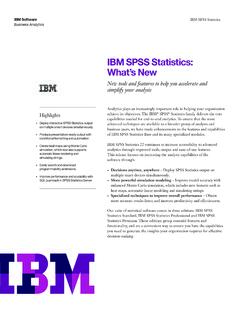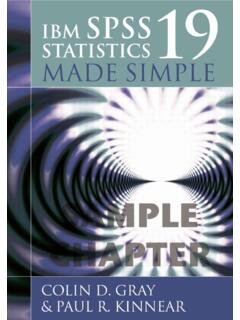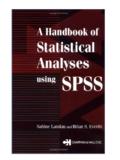Transcription of SPSS - magic
1 SPSS1 SPSSIBM SPSSSPSS x86 running on Windows 7 x86 Developer(s)IBM CorporationInitial release1968 Stable August 16, 2011 Operating systemWindows, zLinux, Linux / UNIX & MacPlatformJavaTypeStatistical analysis, Data Mining, Text Analytics, Data Collection, Collaboration & DeploymentLicenseProprietary [1] spss is a computer program used for survey authoring and deployment (IBM spss Data Collection), data mining(IBM spss Modeler), text analytics, statistical analysis, and collaboration and deployment (batch and automatedscoring services).Statistics programSPSS (originally, Statistical Package for the Social Sciences) was released in its first version in 1968 after beingdeveloped by Norman H. Nie and C. Hadlai Hull. spss is among the most widely used programs for statisticalanalysis in social science.
2 It is used by market researchers, health researchers, survey companies, government,education researchers, marketing organizations and others. The original spss manual (Nie, Bent & Hull, 1970) hasbeen described as one of "sociology's most influential books".[2] In addition to statistical analysis, data management(case selection, file reshaping, creating derived data) and data documentation (a metadata dictionary is stored in thedatafile) are features of the base included in the base software: Descriptive statistics: Cross tabulation, Frequencies, Descriptives, Explore, Descriptive Ratio Statistics Bivariate statistics: Means, t-test, ANOVA, Correlation (bivariate, partial, distances), Nonparametric tests Prediction for numerical outcomes: Linear regression Prediction for identifying groups: Factor analysis, cluster analysis (two-step, K-means, hierarchical), DiscriminantThe many features of spss are accessible via pull-down menus or can be programmed with a proprietary 4GL command syntax language.
3 Command syntax programming has the benefits of reproducibility, simplifying repetitive tasks, and handling complex data manipulations and analyses. Additionally, some complex applications can only be programmed in syntax and are not accessible through the menu structure. The pull-down menu interface also generates command syntax; this can be displayed in the output, although the default settings have to be changed to make the syntax visible to the user. They can also be pasted into a syntax file using the "paste" button present in each menu. Programs can be run interactively or unattended, using the supplied Production Job Facility. Additionally aSPSS2"macro" language can be used to write command language subroutines and a Python programmability extension canaccess the information in the data dictionary and data and dynamically build command syntax programs.
4 The Pythonprogrammability extension, introduced in spss 14, replaced the less functional SAX Basic "scripts" for mostpurposes, although SaxBasic remains available. In addition, the Python extension allows spss to run any of thestatistics in the free software package R. From version 14 onwards spss can be driven externally by a Python or program using supplied "plug-ins". spss places constraints on internal file structure, data types, data processing and matching files, which togetherconsiderably simplify programming. spss datasets have a 2-dimensional table structure where the rows typicallyrepresent cases (such as individuals or households) and the columns represent measurements (such as age, sex orhousehold income).
5 Only 2 data types are defined: numeric and text (or "string"). All data processing occurssequentially case-by-case through the file. Files can be matched one-to-one and one-to-many, but not graphical user interface has two views which can be toggled by clicking on one of the two tabs in the bottom leftof the spss window. The 'Data View' shows a spreadsheet view of the cases (rows) and variables (columns). Unlikespreadsheets, the data cells can only contain numbers or text and formulas cannot be stored in these cells. The'Variable View' displays the metadata dictionary where each row represents a variable and shows the variable name,variable label, value label(s), print width, measurement type and a variety of other characteristics. Cells in bothviews can be manually edited, defining the file structure and allowing data entry without using command may be sufficient for small datasets.
6 Larger datasets such as statistical surveys are more often created in dataentry software, or entered during computer-assisted personal interviewing, by scanning and using optical characterrecognition and optical mark recognition software, or by direct capture from online questionnaires. These datasetsare then read into can read and write data from ASCII text files (including hierarchical files), other statistics packages,spreadsheets and databases. spss can read and write to external relational database tables via ODBC and output is to a proprietary file format (*.spv file, supporting pivot tables) for which, in addition to thein-package viewer, a stand-alone reader can be downloaded. The proprietary output can be exported to text orMicrosoft Word, PDF, Excel, and other formats.
7 Alternatively, output can be captured as data (using the OMScommand), as text, tab-delimited text, PDF, XLS, HTML, XML, spss dataset or a variety of graphic image formats(JPEG, PNG, BMP and EMF).The spss logo used prior to the renaming in Server is a version of spss with a client/server had some features not available in the desktop version, such asscoring functions (Scoring functions are included in the desktopversion from version 19).VersionsEarly versions of spss were designed for batch processing onmainframes, including for example IBM and ICL versions,originally using punched cards for input. A processing run read acommand file of spss commands and either a raw input file offixed format data with a single record type, or a 'getfile' of datasaved by a previous run.
8 To save precious computer time an 'edit'run could be done to check command syntax without analysing thedata. From version 10 ( spss -X) in 1983, data files could containmultiple record versions and later run under Windows, Mac, and Linux. The graphical user interface is written in Java. The Mac OS version is provided as a Universal binary, making it fully compatible with both PowerPC andSPSS3 Intel-based Mac to spss , different versions of spss were available for Windows, Mac OS X and Unix. The Windowsversion was updated more frequently, and had more features, than the versions for other operating version for Mac OS X was not compatible with Intel-based Macintosh computers, due to the Rosettaemulation software causing errors in calculations.
9 spss for Windows needed a downloadable hotfix to beinstalled in order to be compatible with Windows historyBetween 2009 and 2010, the premier vendor for spss was called PASW (Predictive Analytics SoftWare) company announced on July 28, 2009 that it was being acquired by IBM for US$ billion.[3] As of January2010, it became " spss : An IBM Company". Complete transfer of business to IBM was done by October 1, 2010. Bythat date, spss : An IBM Company ceased to exist. IBM spss is now fully integrated into the IBM Corporation, andis one of the brands under IBM Software Group's Business Analytics Portfolio, together with IBM modules provide additional capabilities. The available modules are: spss Programmability Extension (added in version 14). Allows Python, R, and.
10 NET programming control ofSPSS. spss Data Preparation (added in version 14). Allows programming of logical checks and reporting of suspiciousvalues. spss Regression - Logistic regression, ordinal regression, multinomial logistic regression, and mixed models. spss Advanced Models - Multivariate GLM and repeated measures ANOVA (removed from base system inversion 14). spss Decision Trees. Creates classification and decision trees for identifying groups and predicting behaviour. spss Custom Tables. Allows user-defined control of output for reports. spss exact tests . Allows statistical testing on small samples. spss Categories spss Forecasting spss Conjoint spss Missing Values. Simple regression-based imputation. spss Complex Samples (added in Version 12). Adjusts for stratification and clustering and other sampleselection biases.












